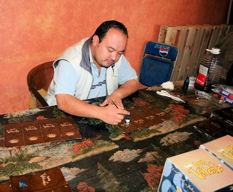
 |
|
Quick links
Talk tequila:Join the discussion forum to ask questions, make comments, vote in polls, rate your favourite tequilas or simply meet other tequila aficionados.
Tequila sips:The part of the plant that is used for tequila is the heart (root), or piña (also called the head, or cabeza), which looks like a large pineapple or pinecone. It starts underground, but soon pushes its way into the light. A mature piña usually weighs 80 to more than 300 pounds (although most are under 200 pounds). Even 500-lb. piñas have been cultivated in the highlands, although they are rare today.
Updated June 27, 2007 |
Labels - hidden clues and directions
Labels may also show off the creative and artistic styles of the producer, with work by talented artists and designers.
There are several elements you should be able to recognize on any tequila bottle label:
Those items marked with an asterisk (*) are required on the main panel. Bottles made for consumption mostly in Mexico will probably have labels in Spanish only, but those made for export will have both, or may even be entirely in English.
 A new addition can be found on 4 Copas' bottles (La
Quemada distillery): certified organic. As of spring, 2007, they
were the only tequila company certified as organic to meet US and
European standards. A new addition can be found on 4 Copas' bottles (La
Quemada distillery): certified organic. As of spring, 2007, they
were the only tequila company certified as organic to meet US and
European standards.Another seal on some bottles is "Envasado de Origen" - bottled at the origin. Some producers lease space in distilleries to make their tequila, and sometimes take it away to age and bottle in another location. Some labels will also have words like "natural" or "estate bottled." Neither of these have any official meaning under the CRT regulations.
 What you won't see on a tequila label
is a vintage such as a season or a year. Tequila does not depend on a seasonal harvest, since
the agave is harvest year round. And with few exceptions, tequilas
are blended (and may contain tequila from older or younger barrels), rather than single-barrel products (in part because
barrels are 600l or less, although a few single-barrel añejos have
been produced). Update: Casa Noble recently released a single-barrel
reposado! What you won't see on a tequila label
is a vintage such as a season or a year. Tequila does not depend on a seasonal harvest, since
the agave is harvest year round. And with few exceptions, tequilas
are blended (and may contain tequila from older or younger barrels), rather than single-barrel products (in part because
barrels are 600l or less, although a few single-barrel añejos have
been produced). Update: Casa Noble recently released a single-barrel
reposado!Fancy bottles also provide a design challenge: how can producers fit all the required content onto a bottle designed to present an attractive, sophisticated and generally uncluttered look? Digital printing, and laser-etching have been partial solutions. others have gone to artistic - even hand-painted - labels on the front, with the necessary information crammed on the back. Items like the NOM identifier are sometimes reproduced in tiny print to reduce the visual impact of the printing on the bottle or label.
Sources
|
||
